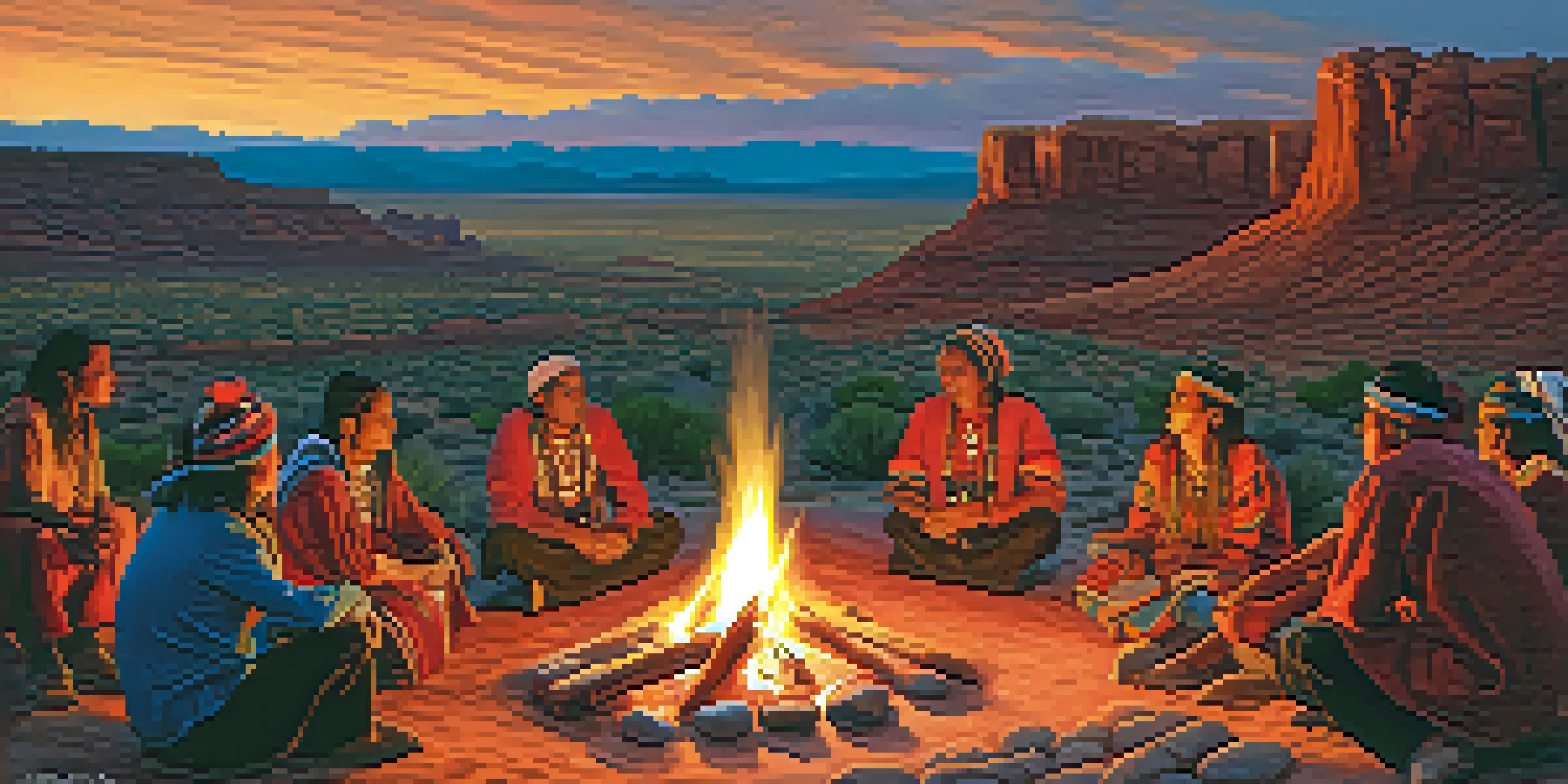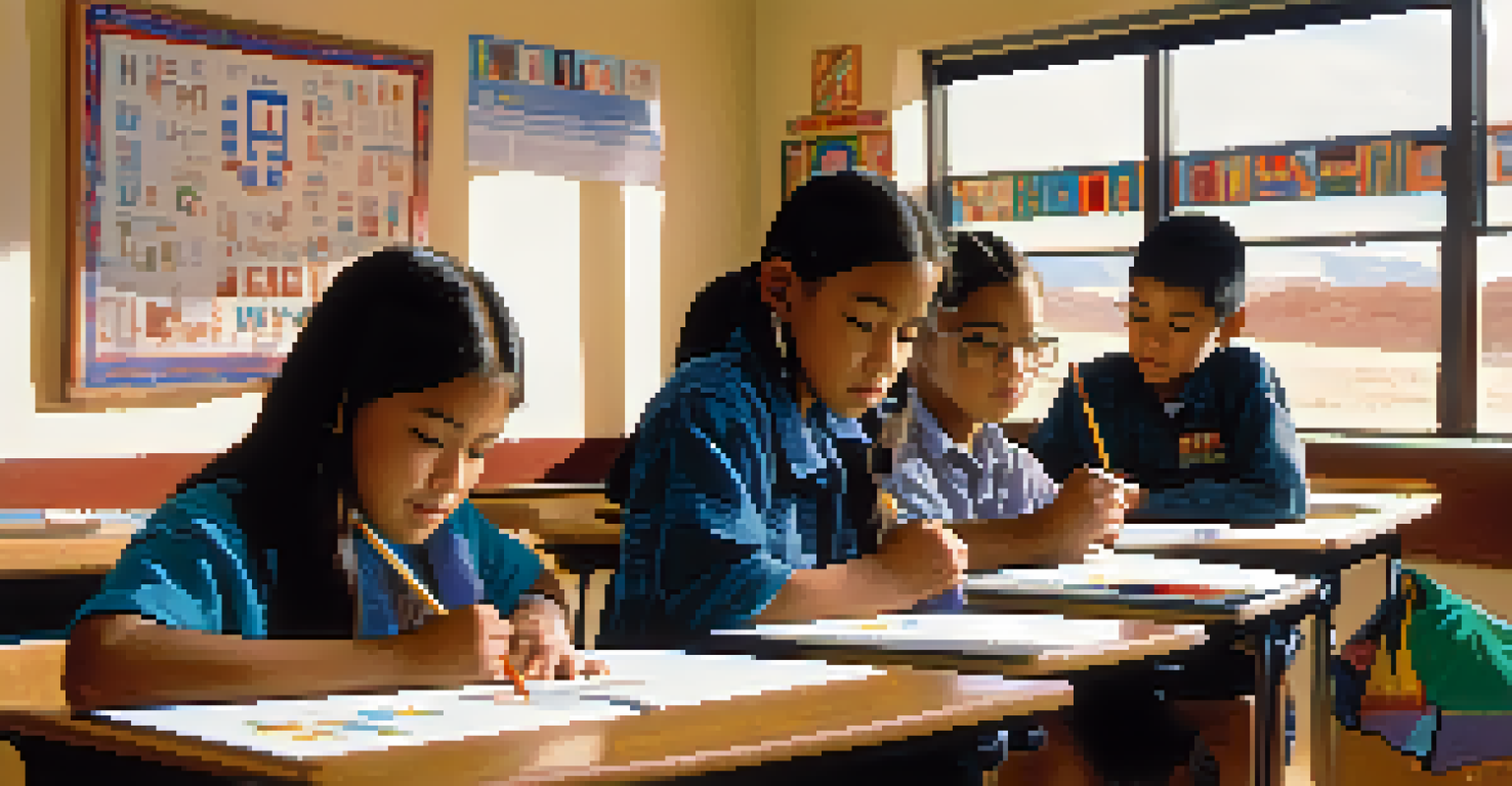Navajo Language: Its Significance and Current Usage

Understanding the Navajo Language and Its Origins
The Navajo language, known as Diné Bizaad, is a rich and complex tongue that belongs to the Athabaskan language family. Originating in the southwestern United States, it has deep cultural roots, reflecting the traditions and history of the Navajo people. The language's unique structure and sounds make it distinct, often challenging for non-speakers to master.
Language is the road map of a culture. It tells you where its people come from and where they are going.
Historically, the Navajo people have used their language not just for communication, but as a key element of their identity. It carries stories, songs, and oral histories that have been passed down through generations. This oral tradition is vital for preserving the culture and ensuring that ancient wisdom remains alive.
Despite its importance, the Navajo language faced significant threats, particularly during the era of forced assimilation. However, efforts to revitalize and promote the language have gained momentum, emphasizing its role in cultural preservation and education.
The Cultural Significance of the Navajo Language
The cultural significance of the Navajo language goes beyond mere words; it encapsulates the worldview and philosophies of the Navajo people. Language is a vessel for cultural practices, beliefs, and ceremonies, allowing the community to maintain a strong connection to their ancestors. It plays a central role during important events, such as weddings and healing ceremonies.

Additionally, the language fosters a sense of community and belonging among Navajo speakers. It serves as a bridge between generations, enabling elders to pass on knowledge and traditions. This intergenerational transmission is crucial for the survival of cultural practices that are often tied to specific words and phrases in Navajo.
Cultural Roots of Navajo Language
The Navajo language embodies the traditions and identity of the Navajo people, serving as a vital means of preserving their cultural heritage.
In many ways, the language is seen as a living entity that reflects the adaptability and resilience of the Navajo people. As they navigate modernity, the language continues to evolve, incorporating new terms and concepts while preserving its core identity.
Current Usage of the Navajo Language in Daily Life
Today, the Navajo language is experiencing a resurgence, particularly among younger generations. Schools on the Navajo Nation are increasingly incorporating Diné Bizaad into their curricula, providing students with opportunities to learn and engage with their heritage. This educational approach not only promotes language fluency but also builds pride in Navajo identity.
A language is something infinitely greater than grammar and philology. It is the poetic testament of the genius of a race and the culture which has created it.
Beyond the classroom, community events and social media platforms are being utilized to foster language use among young Navajos. Initiatives like language immersion programs and cultural workshops are gaining popularity, helping to create a vibrant environment where the language can thrive. These efforts are crucial for ensuring that the language remains relevant in a rapidly changing world.
Moreover, the use of Navajo in everyday conversations, music, and even online content has become more prevalent. This integration into various aspects of life showcases a growing commitment to keeping the language alive and accessible to all.
Challenges Facing the Navajo Language Today
Despite the positive trends, the Navajo language still faces significant challenges. The number of fluent speakers has dwindled over the years, primarily due to historical trauma and the legacy of assimilation policies. This puts the language at risk, as fewer individuals are able to pass it down to future generations.
Another major hurdle is the dominance of English in everyday life, which often overshadows the use of Navajo. Many young Navajos find themselves in environments where English is the primary language, leading to a gradual decline in their use of Diné Bizaad. This phenomenon highlights the importance of creating spaces where Navajo can be spoken freely and confidently.
Challenges to Language Survival
The Navajo language faces significant challenges due to historical trauma, the dominance of English, and a dwindling number of fluent speakers.
Additionally, there is a lack of resources for learning and teaching the language, particularly in remote areas. While there are dedicated programs, more comprehensive efforts are needed to make learning materials accessible and engaging for new learners.
The Role of Technology in Preserving Navajo Language
Technology has emerged as a powerful ally in the preservation and revitalization of the Navajo language. Various apps, online courses, and social media platforms are being developed to facilitate language learning and practice. This digital shift not only appeals to younger audiences but also makes language resources more accessible to a broader audience.
For instance, language apps can teach vocabulary and pronunciation in an interactive manner, making learning more engaging. Social media platforms provide a space for speakers to connect, share content, and promote the use of Navajo in contemporary contexts, helping to normalize the language in everyday conversations.
Moreover, virtual language events and webinars allow for participation from individuals across the globe, fostering a sense of community among Navajo speakers and learners. This technological integration plays a crucial role in ensuring that the language continues to thrive in a digital age.
Community Efforts to Revitalize the Navajo Language
Community-driven initiatives are essential for the revitalization of the Navajo language. Local organizations and cultural centers are leading efforts to create immersive language programs that engage participants of all ages. These initiatives often combine language learning with cultural activities, reinforcing the connection between language and identity.
One successful approach involves hosting language camps where participants can learn Navajo through traditional crafts, storytelling, and community gatherings. By framing language learning within cultural contexts, these programs highlight the practical usage of the language in daily life.
Technology Aids Language Revitalization
Innovative technologies, including apps and social media, are playing a crucial role in making the Navajo language more accessible and engaging for younger generations.
Furthermore, collaborations with local schools and universities are fostering a more comprehensive approach to language education. By involving various stakeholders, these efforts ensure that the language remains a living part of the community's fabric.
The Future of the Navajo Language: Hope and Possibilities
As we look to the future, there is a sense of hope surrounding the Navajo language. The increasing awareness of its cultural significance and ongoing revitalization efforts signal a positive trend. With a dedicated community and supportive resources, the language is poised to thrive for generations to come.
Young Navajos are taking active roles in preserving their heritage, utilizing technology and creative expression to engage their peers. This grassroots enthusiasm is vital for ensuring that the language not only survives but flourishes in a modern context.

Ultimately, the future of the Navajo language lies in the hands of its speakers and supporters. By fostering a culture of pride, connection, and education, the Navajo community can continue to celebrate and share their language with the world, ensuring its place in both history and the future.